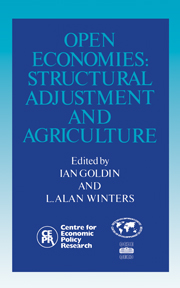Book contents
- Frontmatter
- Contents
- List of figures
- List of tables
- Preface
- Acknowledgements
- List of conference participants
- 1 Introduction: from macro to maize
- Part One Open economy analysis
- Part Two The small country assumption and trade reform
- Part Three Risk and adjustment
- 9 Markets, stabilisation and structural adjustment in Eastern European agriculture
- Discussion
- 10 Should marketing boards stabilise prices through forward purchases?
- Discussion
- Part Four Government's role
- Index
Discussion
from Part Three - Risk and adjustment
Published online by Cambridge University Press: 04 August 2010
- Frontmatter
- Contents
- List of figures
- List of tables
- Preface
- Acknowledgements
- List of conference participants
- 1 Introduction: from macro to maize
- Part One Open economy analysis
- Part Two The small country assumption and trade reform
- Part Three Risk and adjustment
- 9 Markets, stabilisation and structural adjustment in Eastern European agriculture
- Discussion
- 10 Should marketing boards stabilise prices through forward purchases?
- Discussion
- Part Four Government's role
- Index
Summary
Chapter 10 is a well conceived paper which presents many interesting ideas and results. Much consideration has been given to the use of forward purchases and futures market to stabilise prices. The paper shows that the results for farmers of such stabilisation effects would be minimal at best. Most of us are aware that drawing policy conclusions using a theoretically-based simulation model may be risky. However, the present paper does offer insights which could provide the basis for a more in-depth study.
The model itself is cleverly structured and the policy simulations are informative. An essential step of any modelling procedure is to provide some indication of a model's validity so that the validity of the results obtained can be assessed. In this case, the simulation results have been transformed to yield the standard deviations in addition to the means of the solved endogenous variables. In all cases, the means are large relative to the standard deviations, which lends credence to the results. In further work on models of this type, some encouragement should be given to performing simulations in the context of experimental design (parameter testing). This could very well require the production of a version of the model which is more conventionally econometric in character.
- Type
- Chapter
- Information
- Open EconomiesStructural Adjustment and Agriculture, pp. 240 - 242Publisher: Cambridge University PressPrint publication year: 1992



